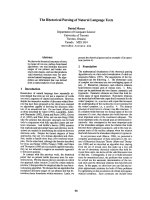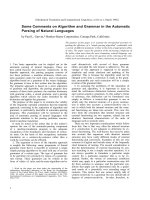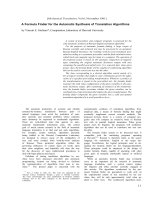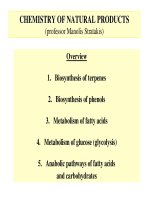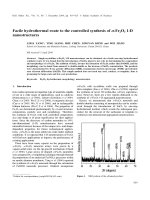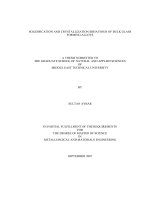Volume 6 the total synthesis of natural products
Bạn đang xem bản rút gọn của tài liệu. Xem và tải ngay bản đầy đủ của tài liệu tại đây (11.32 MB, 296 trang )
THE TOTAL SYNTHESIS
OF NATURAL PRODUCTS
The Total Synthesis
of Natural Products
VOLUME 6
Edited by
John ApSimon
Ottawa-Carleton Institute for Research and Graduate Studies in Chemistry
and
Department of Chemistry
Carleton University, Ottawa
A WILEY-INTERSCIENCE
PUBLICATION
JOHN WILEY & SONS
NEWYORK * CHICHESTER BRISBANE
TORONTO
0
SINGAFORE
A NOTE TO THE READER
This book has been electronically reproduced from
digital information stored at John Wiley & Sons, Inc.
We are pleased that the use of this new technology
will enable us to keep works of enduring scholarly
value in print as long as there is a reasonable demand
for them. The content of this book is identical to
previous printings.
Copyright 8 1984 by John Wiley & Sons, Inc.
All rights reserved. Published simultaneously in Canada.
Reproduction or translation of any part of this work
beyond that permitted by Section 107 or 108 of the
1976 United States Copyright Act without the permission
of the copyright owner is unlawful. Requests for
permission or further information should be addressed to
the Permissions Department, John Wiley & Sons, Inc.
Library of Congress Cataloging in Publication Data:
(Revised for volume 6 )
ApSimon , John.
The total synthesis of natural products.
Includes bibliographical references.
1. Chemistry, Organic-Synthesis. 2. Natural products.
I. Title.
QD262.A68
547.7
72-4075
ISBN 0-471-03251-4 (v. I )
ISBN 0-471-09900-7 (v. 6)
10 9 8 7 6 5
4
3 2
1
Contributors
to Volume 6
John W. ApSimon, Department of Chemistry, Carleton University, Ottawa
Kim E. Fyfe, Department of Chemistry, Carleton University, Ottawa
Austin M. Greaves, Department of Chemistry, Carleton University, Ottawa
G. Grynkiewicz, Institute of Organic Chemistry, Polish Academy of Sciences,
Warsaw
A.H. Jackson, Department of Chemistry, University College, Cardiff, Wales
Saran A. Narang, Division of Biological Sciences, National Research Council
of Canada, Ottawa
K.M. Smith, Department of Chemistry, University of California, Davis
Wing L. Sung, Division of Biological Sciences, National Research Council of
Canada, Ottawa
David Taub, Merck Sharp and Dohme Research Laboratories, Rahway
Robert H. Wightman, Department of Chemistry, Carleton University, Ottawa
A. Zamojski, Institute of Organic Chemistry, Polish Academy of Sciences,
Warsaw
V
Preface
The first five volumes in this series have been concerned with describing in a
definitive manner the total synthetic approach to various classes of natural products.
This volume continues the series with chapters describing the reports and
progress in the total synthesis of aromatic steroids, carbohydrates, genes, pyrrole
pigments, and triterpenoids since the appearance of Volumes 1 and 2 some ten
years ago.
There have been some delays in producing this volume at the Editor’s end
caused by the requirement of retyping and the structure drafting; however, this
series of chapters brings the reader up to date with progress in the diverse classes
of compounds examined herein. My particular thanks are due to Karl Diedrich
of Carleton University for his efforts in the production of the various manuscripts.
The seventh volume in this series is in preparation and is planned for publication in about one year, covering the synthesis of diterpenes, diterpene alkaloids, macrwycles, and anthracyclinones.
JOHN APSIMON
Ottawa, Canada
January 1984
Vii
Contents
The Total Synthesis of Aromatic Steroids 1972-1981
1
DAVIDTAUB
Gene Synthesis
51
SARANA. NARANG,WINGL. SUNG,and ROBERTH. WIGHTMAN
The Total Synthesis of Triterpeaes 1973-1981
JOHN W. APSIMON,KIM E. FYFE,and AUSTINM.GREAVES
The Total Synthesis of Carbohydrates 1972-1980
85
141
A. ZAMOJSKI
and G. GRYNKIEWICZ
The Total Synthesis of Pyrrole Pigments 1973-1980
237
Index
281
A.H. JACKSON and K.M.SMITH
THE TOTAL SYNTHESIS
OF NATURAL PRODUCTS
The Total Synthesis of Natural Products, Volume6
Edited by John ApSimon
Copyright © 1984 by John Wiley & Sons, Inc.
The Total Synthesis
of Aromatic Steroids
1972-1981
DAVID TAUB
Merck Sharp & Dohme Research Luborarories,
Rahway, New Jersey
1. Introduction
2. Equilenin
A. Posner Synthesis
3. Estrone and Related IPNorsteroids
A. Amino Acid Mediated Asymmetric Cyclizations
(a) Introduction
(b) Hoffman-LaRoche Syntheses
(c) Schering A.G. Syntheses
(d) Danishevsky Syntheses
(e) Tsuji Syntheses
B. Orthoquinodmethane Approach
(a) Introduction
(b) Kametani Syntheses
(c) Oppolzer Syntheses
(d) Nicolau Synthesis
(e) Vollhardt Synthesis
(f) Quinkert Synthesis
(9) Grieco Synthesis
2
2
2
4
4
4
7
8
10
13
16
16
17
20
25
25
27
29
1
2
The Total Synthesis of Aromatic Steroids 1972-1981
(h) Tsuji Synthesis
(i) Saegusa Synthesis
Q) Magnus Synthesis
C. Miscellaneous
(a) Saucy Synthesis
(b) Johnson Synthesis
(c) Daniewski Synthesis
(d) Bryson Synthesis
(e) Posner Synthesis
(9 Mander Synthesis
(g) Ziegler Synthesis
Acknowledgment
References
31
33
34
31
31
38
40
40
41
45
45
41
41
1. INTRODUCTION
This review covers the literature published during 1972-1981 and updates the
chapter on the total synthesis of naturally occurring aromatic steroids that appeared in Volume 2 (pp. 641-725) of this series.
Extensive synthetic effort has continued to be directed toward the aromatic
steroids exemplified by estrone-and toward the related 19-norsteroids-not only
because of their practical medical and commercial importance but because they
serve admirably as templates for the display of new organic synthetic methodology.
The major innovations include:
1. Development of asymmetric syntheses involving chirality transfer to prochiral substrates, in particular the use of amino acids as catalysts in chirally
directed aldol cyclizations.
2. Development of synthetic routes based on generation and intramolecular
cycloaddition of orthoquinodimethanes.
2.
EQUILENIN
A.
Posner Synthesis
Posner and co-workers have developed an efficient (52% overall yield) conversion of 2-methyl-2-cyclopentenoneinto ( 2 )-1 1-0xoequilenin methyl ether, 4
(Scheme I).' The latter had been hydrogenolyzed earlier to equilenin methyl
ether by Birch (see Volume 2, p. 660).
Equuenin
3
0
n
0
2
0
0
Scheme I
2-Methyl-2-cyclopentenone1 was treated sequentially with (6-methoxy-2naphthyl)(1-pentynyl)coppermagnesium bromide and ethyl iodoacetate to give
the stereochemically pure trans keto ester 2 in >95% yield (Scheme 1). The
yield was considerably lower when the corresponding aryl(alkyny1)lithium cuprate and methyl bromoacetate were utilized. Analogous reactions with the smaller
vinyl group instead of 6-methoxy-2-naphthyl were not as clean stereochemically,
producing appreciable amounts of cis isomers (see below, orthoquinodimethane
a p p r o a ~ h ~ ~ oConversion
~ - ~ ~ ) . of 2 to the corresponding ethylene ketal, saponification, and Friedel-Crafts cyclization in liquid hydrogen fluoride led to ( 2 ) 11-oxoequilenin 3-methyl ether, 4. Curiously, the cyclization yield was appreciably higher with the ethylene ketal acid 3 than with the corresponding 17ketone.
Extension to the natural ( +) series was accomplished by transfer of chirality
from sulfur to carbon via ( + )-2-tolylsulfinyl-2-cyclopentenone,
7& (Scheme 2).
The latter was prepared in optically pure form from the ethylene ketal of 2bromo-2-cyclopentenone 5 by lithiation and treatment with ( - )-menthy1 p-toluenesulfinate to yield ( + ) 6, followed by deketalization. Conjugate addition of
6-methoxy-2-naphthylmagnesiumbromide to ( ) 7 followed by in siru methylation gave stereochemically pure 8a in 42% yield along with 40-50% of unmethylated analog 8b. More vigorous methylation conditions led to elimination
of p-toluenesulfinic acid. Generation of enolate 9 with dimethylcopperlithium
followed by alkylation with methyl bromoacetate then led to (+)-methyl ester
10. The overall yield of ( +) 4 is 25% based on the Friedel-Crafts procedure
developed for the racemic series.
Sulfoxide (+) 7 has also been utilized in effective chiral syntheses of (3s)2-methyl-3-vinylcyclopentanone128* and the corresponding trimethylsilyl enol
+
4
The Total Synthesis of Aromatk Steroids 1972-19%1
0
-
1) (CH2OH)z /
2) n-BuLi
3) ( - ) Tol-;O-menthyl*
1
CuSO4/ acetone
9
Tol-!&
(+)
2
8a, R=Me
&, R I H
MeZCuLi
ether-THF
O o / 2 hr
’
i
L
J
2
(+)
lo
(42%)
(40-50%)
(89%)
Scheme 2
ether [cf. ( 2 ) 9535*42*26],
ring D synthons in orthoquinodimethane approaches
discussed below. Conjugate addition of vinylmagnesium bromide to ( + ) 7 occurred with 100% asymmetric induction when zinc bromide was added first to
preform the zinc chelate.
3. ESTRONE AND RELATED IkNORSTERODS
A.
Amino Acid Mediated Asymmetric Cyclizations
(a) Introduction
A major advance, of significance not only for steroid synthesis but also for
organic synthesis in general,3 is the finding that aldol type cyclizations of prochiral substrates can be catalyzed by chiral a-amino acids to yield chiral products
of high optical purity. The discovery was made independently by groups at
Schering A.G. (Berlin)4 and Hoffman-LaRoche (Nutley, N.J.)5 in the devel-
EPtroae and Related 19-Norsteroids
5
opment of routes to chiral hydrindenones as CD part structures in CD --* ABCD
approaches to 19-norsteroids. Some representative examples are shown here:
11
12
0
p-@
0
14
(a)
(b)
R
=
R
s
H
R = CH~CHZCOOCH~
Yields in the Michael condensation for preparation of the triones 13 were
improved by operating in aqueous media and omitting basic c a t a l y ~ i s . For
~.~
example, trione 13a was obtained in 88% yield by stirring a mixture of methyl
vinyl ketone l l a and 2-methylcycIopenbne-1,3-dione12 in water at 20" for 5
days.6This Michael condensation is considered to be self-catalyzedby the acidic
1,3-di0ne.~
trione 13a, L-proline, and 1N perchloric acid
In the Schering route to
(molar ratios 1:0.5:0.27) in refluxing acetonitrile for 22 hours afforded an 87%
yield of ( + ) 15a of 84% optical purity. A l t e r n a t i ~ e l y ,13a
~ . ~in dimethyl formamide containing 0.05% water and 1% by weight of p pro line at 20" for 22.5
hours yielded ketol 14a, which on treatment with p-toluenesulfonic acid in
benzene gave ( + ) 15a in 94% yield of 87% optical purity.
In the above examples, L-a-amino acids induce the natural 13P-chirality.
Amines or amino acid derivatives (esters, amides) are much less effective, and
a tertiary amino acid, hygrinic acid, was ineffective. For trione 13a, secondary
amino acids (e.g., proline) are best; for 13b and 13c [R > H, see also the
syntheses below], a primary
Danishevsky (Scheme 8)19 and Tsuji (Scheme
amino acid (e.g., L-phenylalanine) is preferred. The mechanism of the reaction
has not yet been
Applications of the chiral hydrindenone syntheses to industrially feasible
routes to 19-norsteroids and their (of necessity) totally synthetic 18-ethyl counterparts (e.g., norgestrel) were then developed.
a+
d
’
17
H2 / 10% Pd-Bas04
MeOH 10’
’
37% CHZO / DMSO
p l p e r l d i n e I 200
0’
HOd
100%)
19
&
e
20
-
O
COOE t
f
@
1)
H+
HO
4 ) CH3COBr
(CH3CO)zO
22
aq. NaOH
MeOH / 200-
‘
26
-
25
Scheme 3
(95%)
&
1 ) H2 /PdC 1 EtOH 165’
2 ) 6N HC1/ E t O H I A
24
-
6
0
HZC
(‘v
e
’
( N 74%)
(507. from
u)
Estrone and Related 19-Norsteroids
0
@+
CH2
C u I /THF
+
>
&
Me0
7
'
Meo&MgCI
27
19
(8877)
?+
CH3OH
0'
HC1/ 2
1) H2 l P d C
'
Me0
27a
(71% from
2)
CF3COOH
3)
cr03
28
19)
(62%)
Scheme 4
(b) Hofmn-Ldtoche Syntheses
At the outset of the Hoffman-LaRoche route' (Scheme 3), hydrindendione 15a
was converted into the corresponding 17p (steroid numbering) r-butyl ether 16.
Carbonation with magnesium methyl carbonate then yielded unsaturated acid 17.
The latter was the chosen intermediate because it was known that the direction
of hydrogenation of the double bond in hydrindenones 15 is strongly dependent
on the nature of the substituent R9*I0and that carboxyl, ester, and methyl aryl
sulfone"O functionality strongly favor reduction from the a-face to give the
desired C/D trans stereochemistry. Furthermore, carboxyl was required as a
removable activating group in the Mannich reaction step that followed reduction.
Hydrogenation was carried out at 0" to minimize decarboxylation of the
saturated 9-keto acid product 18. Mannich reaction proceeded with in situ decarboxylation to afford a-methylene ketone 19, which on Michael reaction with
ketal p-keto ester 208-" yielded adduct 21. Saponification, B ring closure, and
decarboxylation then led to ketaienone 23 in high yield, which was converted
into ( )-19-nortestosterone24 and thence to ( + )- 19-norandrostenedione25 in
50% yield from 18 or 27% overall yield from 12. However, ketal hydrolysis,
A ring closure, oxidation at C-17, and isomerization by the Roussel procedure
(acetyl bromide-acetic anhydride in methylene chloride at 2Oo)l2 should yield
( + )-estrone 26 efficiently.
Alternatively, Cohen et al.13 (Scheme 4) reacted 19 with m-methoxybenzyl
magnesium chloride in the presence of cuprous iodide to produce the 1 ,Cadduct
+
8
The Total Synthesis of Aromatic Steroids 1972-1981
30
1)
34
-
Scheme 5
(85%)
NaOH /MeOH
35
(35% from
3)
27 in good yield. Acid catalyzed B ring closure, hydrogenation, and conversion
to the 17-ketone then yielded (+)-estrone methyl ether 28.
(c) Schering A.G. Syntheses
The Schering group described a route to ( + )-13-P-ethylgon-4-ene-3,17-dione
35 (for conversion to norgestrel), which is clearly adaptable to estrone synthesis.
The key step (Scheme 5)"" is a variant of the Mannich reaction involving
sulfonylmethylation of 29 with formaldehyde and benzenesulfinic acid in 3: 1
triethano1amine:aceticacid at 50' to yield unsaturated sulfone 30. Hydrogenation
of the latter in ethanol: 1% IN hydrochloric acid gave crystalline saturated sulfone
&+
Estrone and Related 19-Norsteroids
&
0
’
Me0 q
+
r
NaHLTHF,
Me0
16
36
HC (OMe ) 3
MeOH I H+ 10’’
0
(84%)
TosOH 1 OH /A
Me0
Me0 One
37
o+
o+
1) cr03/ acetone
2) NaOMe I MeOH
107. PIC / MeOH
Me0
#
9
‘
27a
-
&
27
(84%)
O
Me0
9
t
21)
)
4E /HC1
H2
PdCI /dEtOAc
im.
3)
HBr /HOAc
’
HO
(82%)
(95%)
OH
I
‘
40
(49%)
Scheme 6
31 in 75% yield, with hydrogenolysis of the allylic carbonyl group a minor side
reaction. Condensation of 31 (via enedione 32) with ketal P-keto ester 20 followed by saponification, p ring closure, and decarboxylation then gave tricyclic
ketalenedione 34 (analogous to Hoffman-LaRoche intermediate 23) and thence
35.
The Schering chemists also reported a synthesis of (+)-estradiol 40 based
on direct alkylation of the anion of (+)-16 with rn-methoxyphenacyl bromide
(Scheme 6). l4 The 84% yield obtained was considerably higher than that achieved
10
The Total Synthesis of ArornsHc Steroids 1972-1981
previously utilizing the less active m-methoxyphenethyl halide or tosylate as
alkylating agent (Volume 2, pp. 712, 713). Direct acid-catalyzed formation of
the indenofuran 38 was slow and occurred with some loss of the t-butyl group.
However, prior conversion into the dimethyl acetal 37 permitted smooth furan
formation under mild conditions. Hydrogenation of 38 under moderate pressure
led in high yield to the 8a,l4a-9P-hydroxy compound 39, which on oxidation
and side chain isomerization to the equatorial position afforded the 8&14a-9ketone 27, l 3 converted by standard procedures to 27a and thence to ( + )-estradiol
40.
(d) Danishevsky Syntheses
Danishevsky and co-workers devised an ingenious synthesis of estrone (and other
19-nor-steroids)utilizing 6-substituted a-picolines as ring A synthons in a variant
of the Robinson annulation process.I5 The synthesis was initially applied to ( ?)D-homoestrone and an improved version was developed for ( +)-estrone and
related ( + )- 19-norandrostenones.
Model studies showed that Birch reduction of 6-substituted a-picolines and
hydrolysis of the intermediate bisenamines yield 1,5-diketones, which can cyclize
to enones A and/or B.16 In fact, literature precedent" and experience with 1,4diketones favored cyclization mode B (e.g., jasmone). However, the model
studies showed substantial and in some cases predominant cyclization to A.
In the synthesis of ( f)-D-homoestrone (Scheme 7),lEaS6Michael addition of
the monoketal42 of the Wieland-Miescher enedione to 6-vinyl-2-methylpyridine
41 led to tricyclic adduct 43 in good yield. Reduction to the 17a-fi-alcoho1,
double bond hydrogenation, and ketalization produced 44 with the requisite
SP,14a-stereochemistry in 58% yield. However, modification of the hydrogenation conditions from ethyl acetate-triethylamine to ethanol-perchloric acid raised
the yield to 82%.lECBirch reduction, hydrolysis, cyclization, and ketal reversal
n
48
(82%)
OH
Scheme 7
11
The Total Synthesis of Aromatic Steroids 1972-1981
12
d I5 - 0
51
50
+
(71Y.)
Et3N / EtOAc
N
0
n
OH
L-phenylalanine / 1E HC104 /
CHjCN /A40 hr
54
N
(82Y. yield -867. +)
OH
1)
2)
H2 /PdC /H+
(CH2OH) / li+
(89%)
1) Na / NH3 / EtOH
2) NaOH/ EtOH
’
4) Jones
OX
57
(45%)
1)
TosOH / CH-jCOOH /
2)
0
55
-
(ago%)
CH3COBr/
(CH3CO)zO / CH2C12
K2CO-j / aq. HeOH
HO
58
& (397. from 56)
(13% from 52)
Scheme 8
then led to a single enedionol45 in 93% yield, converted to crystalline enetrione
46 and thence to (&)-D-homoestrone 48 in 21% overall yield from 42. The
absence of the alternative cyclization product 45a anticipated from model studies
may be rationalized on steric grounds.
In initial studies toward (+)-estrone, vinyl picoline 41 was condensed with
hydrindenone 16 in analogy with the reaction of 41 with 42. However, since
the yield in the present case was low, an alternative route was devised (Scheme
8).19 2,6,-Lutidine 50 was converted in 57% yield to the enone 52 (cf. 167,
Volume 2, p. 693), which readily added 2-methylcyclopentane-1,3-dione12 to
give the prochiral bicyclic trione 53 in high yield. Asymmetric cyclization of
53 in the presence of L-phenylalanine-1N perchloric acid (molar ratio 1: 1.2:0.5)
in refluxing acetonitrile by the Eider-Hajos te~hnique'~~
led to (+) 54 of 86%
optical purity in 82% chemical yield. Selective borohydride reduction to 55,
followed by catalytic hydrogenation under acidic conditions, ketalization, and
chromatography gave 56 in only 45% yield along with 17% of the C/D cis isomer
and 21% of hydrogenolysis product (55 C9-H2). The present hydrogenation
difficulties are in sharp contrast with the clean high yield result in the analogous
step in the D-homo series. Elaboration of the ring A enone occurred unidirectionally to give 57 in 90% yield. Ciosure of ring B and isomerization by the
Roussel procedure'2 led to ( +)-estrone 26 in 39% yield from 56 or 13% yield
from 52. The low yield in hydrogenation of the 8( 14) double bond unfortunately
negates the high yield of the asymmetric cyclization.
(e)
Tsyii Syntheses
Tsuji and colleagues have synthesized 1,7-octadiene-3-one 62 from the readily
available butadiene telomer 5920and have explored the utility of 62 in natural
product synthesis, including two routes to 19-norsteroids.21*22
Dimerization of butadiene catalyzed by palladium acetate-triphenylphosphine
yielded a separable mixture of octadiene acetates 59 and 60 in high yield. Acetate
on
0
62
647.
14
&,+
The Total Synthesis of Aromatic Steroids 1972-19%1
2)1) NN~a IH/ /HOH
MPA/A
0
0
64
(68%)
O t
P+
65
I
(90%)
,
I
66
1)
12)
13)
I4 )
d/
OH
(7877)
OH'
H+
ox
CH3COBr/(CH3C0)20
0
1) H g / PdC / EtOH / E t 3 N
HC1 / NeOH / A
2)
24
(72%)
Scheme 9
26
-
60 could be rearranged to 59 by the palladium catalyst. Conversion of 59 to
alcohol 61 and dehydrogenation over copper-zinc alloy in a packed column at
280-360" provided dienone 62 in good yield.20~21~23
The 1-ene-3-one part-structure in 62 can be utilized in Michael addition
reactions and subsequently the remaining double bond can be oxidized to methyl
ketone,24making 62 a bisannulation reagent synthetically equivalent to 7-octene2,6-dione, as is Danishevsky's 6-vinyl-2-picoline (41, Scheme 7).
As shown in Scheme 9,21 (+)-p-keto ester 63 [available by diazomethane
treatment of 18 (Scheme 3)labon Michael reaction with 62, followed by decarbomethoxylation, yielded enedione 64. Aldol cyclization to 65 and palladium
chloride-cuprous chloride catalyzed oxidation of the terminal double bond then
gave tricyclic enedione 66. The latter was converted into ( +)-19-nortestosterone
L-phenylalanine
1N HClO4 / CH3CN / b - 7 2 hr
p ;p
-
6 7 (84%)
62
PdClz/CuCl/O
*q.
68
HC(OMe)3/MeOH
p-TSA I ZOO
Dm
69
(85%)
(77%)
(76% opt . y i e l d )
OH
OH
2) EtOH 1 1 N HC1
p >&+
OMe
72
73
-
2) NaH 1 DMSOI
-
(+I 2 (547.)
(437. from 68)
Scheme 10
’
’
The Total Synthesis of Aromatic Steroids 19724981
16
24 but should also be convertible into (+)-emone 26 as indicated earlier (cf.
Scheme 3, 23 + 26; Scheme 8, 58 + 26).
In the route just described (CD + ABCD), the bisannulation reagent 62 is
the source of rings A and B. In an alternative, somewhat more involved, approachZZ
(D + BCD 4 ABCD; Scheme lo), reagent 62 is the source of rings B and C.
Michael reaction of 62 and 2-methylcyclopentane-1,3-dioneled to adduct 67
in good yield. Asymmetric aldol cyclization with concomitant dehydration was
accomplished using L-phenylalanine- 1Wperchloric acid (molar ratio 1:1:0.4) in
of 76% optical purity in 85% yield.4*S**9
refluxing acetonitrile to produce (+)-a
Palladium chloride catalyzed terminaI olefin oxidation" then yieIded enetrione
69. The latter compound has been prepared by Eder et al.,2' who developed an
effective method for its a-face hydrogenation via the 17P-hydroxydiene system
72 (cf. Scheme 6) which in turn was obtained in good yield via intermediates
double bond of 72 proceeded completely
70 and 71. Hydrogenation of the
in the desired a sense, and the product was hydrolyzed to hydroxydione 73.
Base catalyzed aldol cyclization then provided the tricyclic enone 74. Conversion
of the 17P-hydroxy group to the t-butyl ether and base catalyzed addition of 3butenyl iodide produced the butenylated ketone ( t ) 65 in 54% conversion yield.
The latter had been produced by the earlier route (Scheme 9) and converted into
(+)-19-nortestosterone 24.
Tsuji has also prepared the trisannulation reagent 75 from dienone 62 as
indicated and utilized it in a synthesis of (r)-~homoandrost-4ene-3,17a-dione.~
OH
B. Orthoquinodimethane Approach
(a)
Introduction
Themolysis of benzocyclobutenes and trapping of the intermediate orthoquinodimethanes with external dienophiles was described some time ago by CavaZ7
and by Jensen and Coleman.2* The intramolecular version of this reaction was
Estrone and Related 19-Norsterolds
17
initially studied independently by Oppolzer and Kametani, who have reviewed
its development and application to the stereospecific synthesis of polycyclic
systems, including steroids.29 The main area of interest in the steroid field has
been the synthesis of estrone and related systems, although recently emphasis
has shifted to saturated steroids.30
(b) Kamelani Syntheses
In 1976 Kametani and co-workers described the initial application of o-quinodimethane thermolysis methodology to steroid synthesis in a route to ( f)-Dhomoestrone methyl ether 83a, remarkable for the high yield in the cycloaddition
step, but which suffers from a low yield in the condensation reaction leading to
key intermediate 81 (Scheme 1l).31
The required 2-(4-methoxybenzocyclobutenyl)-ethyl iodide 79 was prepared
by a multistep process from 2-bromo-5-methoxybenzaldehydevia 1-cyano4methoxybenzocyclobutene 77 as illustrated. 2-Methylcyclohexenone was then
converted into 2-methyl-3-vinyl-6-n-butylthiomethylenecyclohexanone80.
Blocking C-6 was considered necessary to insure regiospecific condensation of
79 at C-2. However, the condensation reaction afforded adduct 81 in only 16%
yield. In subsequent work (with 2-methylcyclopentenone) 1:4 addition of a vinyl
Grignard or lithium reagent and coupled alkylation of the intermediate enolate
occurred at C-2 without the need to block C-6 (Scheme 1,’ Scheme 1436v40).
Thermal cycloaddition of 81 proceeded with involvement of the olefinic bond
a to the carbonyl group to give 82.32A similar result was obtained with the
benzylidene analog of 81. It was therefore necessary to remove the C-6 blocking
group prior to cycloaddition. Deblocked adduct 83 on refluxing in o-dichlorobenzene underwent intramolecular cycloaddition smoothly via the indicated sterically favorable ex0 transition state to produce ( & )-D-homoestrone methyl ether
83a in 95% yield. Compound 83a had been previously converted to ( -C )-estrone
by Johnson et al. (see Volume 2, pp. 681-682).
Although condensation leading to the five-membered ring D counterpart of
81 occurred in 26% yield, it was not possible to deblock the latter successfully
to the five-membered ring D counterpart of 83. However, a direct route utilizing
five-membered ring D intermediates was achieved by Kametani in his next
synthesis.
The poor yield in the above alkylation step (79 + 80 + 81) was improved
considerably by placing the iodomethyl group on the ring D precursor and
condensing the latter with 1-cyano-4-methoxybenzocyclobutene(e.g., 77 +
88 + 89, Scheme 12). This modification and utilization of the chiral indanone
84& as starting material led to an asymmetric synthesis of (+)-estradiol 40.32”
Chiral indanone 84 was converted into ( + )-(lS,Zli,3S)-l-t-butoxy-2-(2-iodoethyl)-2-methyl-3-vinylcyclopentane 88 by the indicated multistep procedure.
BrCH2CH20THP
NaNH2 / NH3
’
d C H 2 C H z C r T H P
Me0
1 ) d M g B r / CuI / TW
2 ) HCOOEt / NaH / 8 H
3 ) CqHgSH / T o s O H / 8 H
7 9
18
-
,
80
5c4h9
t-BuOK
+ 8 0
CHZCHZI
Me0
(41%)
1800



